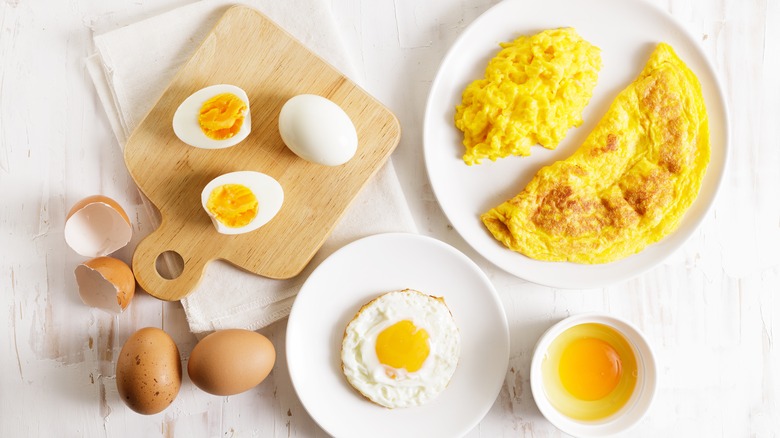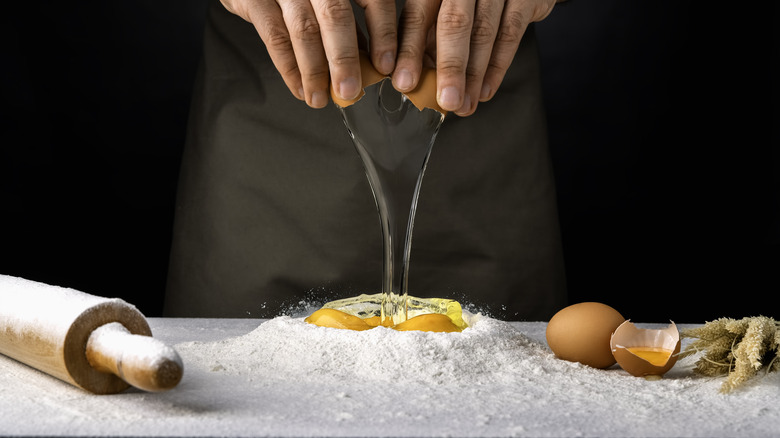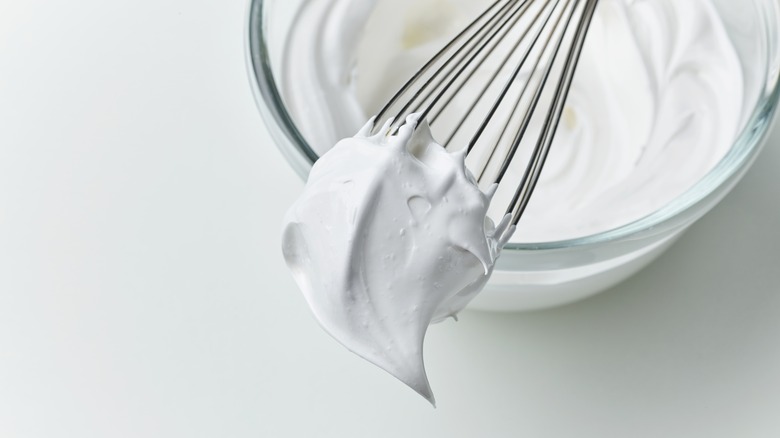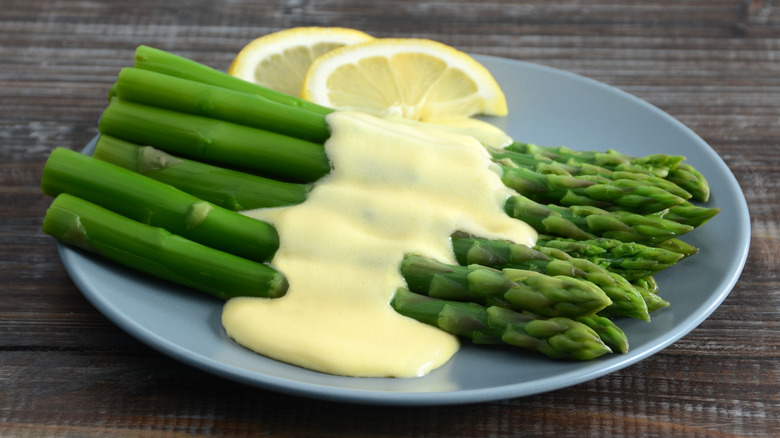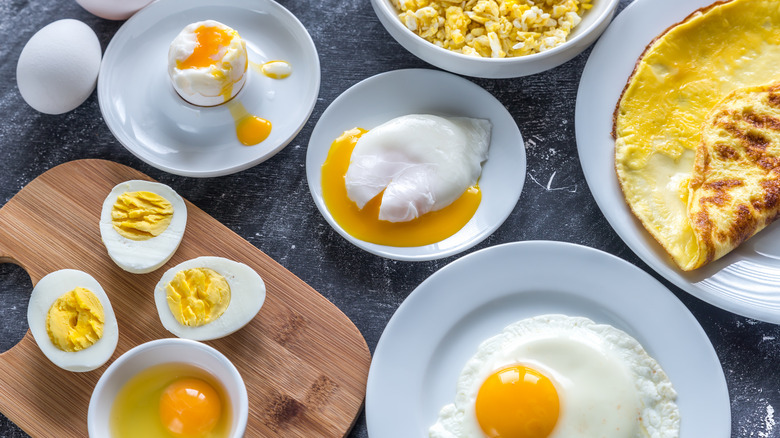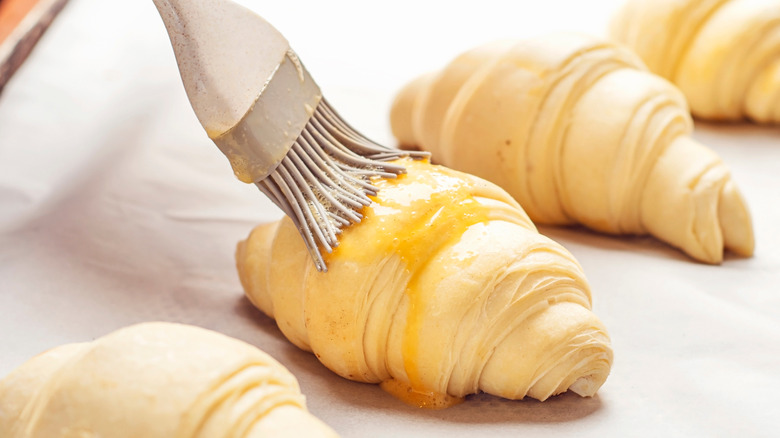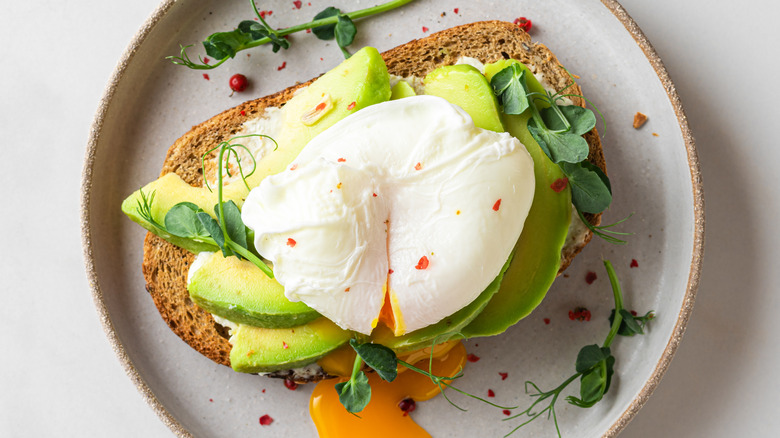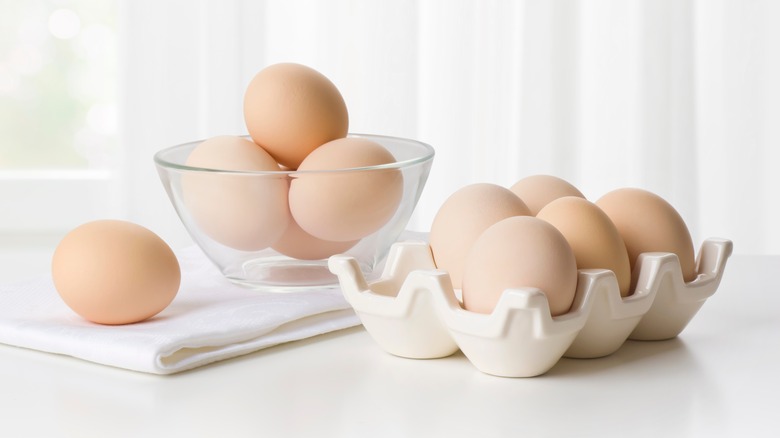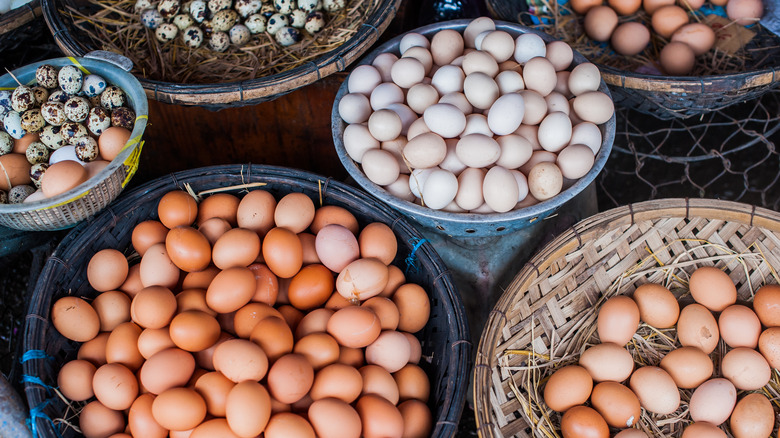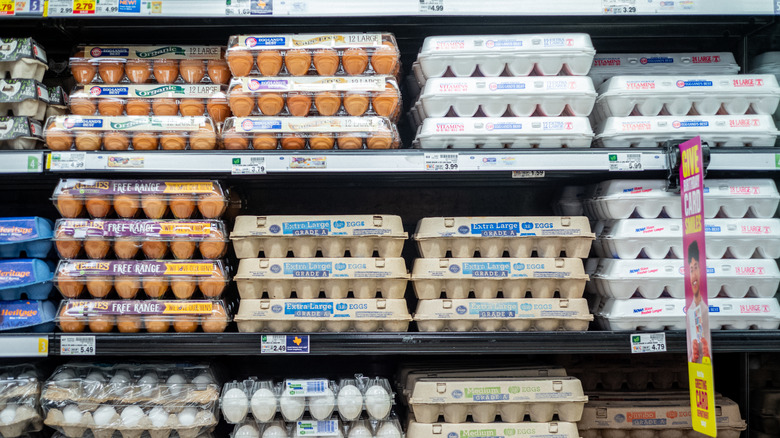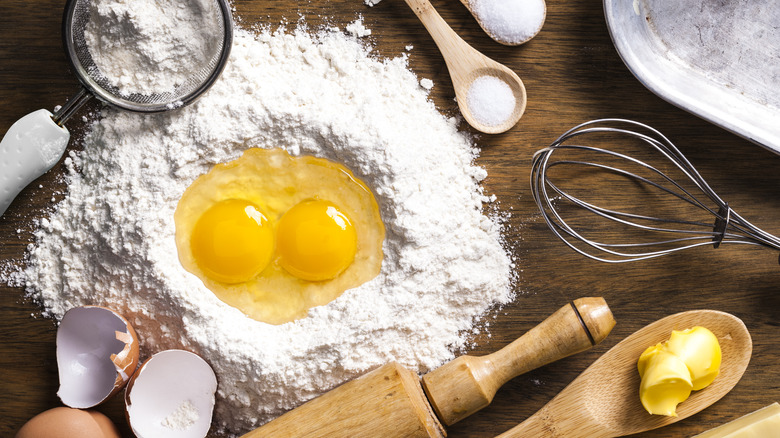Sizzling Reasons Eggs Are One Of The Most Versatile Foods
Eggs are a kitchen staple across the world because of their high nutritional content and incredible versatility. Whether you use them for classic breakfasts, decadent desserts, or velvety sauces, eggs add a crucial quality that is hard (but not impossible) to replace with other ingredients. What exactly makes eggs such a flexible ingredient? The answer is equal parts chemistry and magic. And because boiling it down to a single reason would be harder than nailing a yolk to the wall, It is best to tackle the enigma of the egg point by point.
A great starting point for the discussion is to define exactly what we mean when we talk about eggs. Eggs are the reproductive body of birds, as well as some reptiles, amphibians, and fish. They are typically eaten unfertilized, but fertilized eggs can be used to make dishes like balut. The most common type of egg in the culinary context, though, is by far the non-fertilized chicken egg. However, that's not to say all of this information only applies to chicken eggs. Many of the qualities that make chicken eggs so versatile also apply to other common bird eggs, such as those from the duck, goose, quail, or ostrich. Regardless of which type of bird egg you are familiar with cooking, let's dive into what makes them such a treasure for chefs and epicures alike.
They are the perfect binder for baked goods
From cakes to cookies to pastries, the most popular baked goods feature eggs. That's because all of these confections need structure, and eggs are the best binding agent in your kitchen. When an egg is baked, its proteins coagulate, forming a three-dimensional network that holds the mix of ingredients in place. This process adds stability as well as texture to the final product. That is why cookies without enough egg typically come out brittle and crumbly. This concept goes well beyond the baking world too. Eggs act as culinary glue in a wide range of dishes, including meatloaves, casseroles, quiches, and meatballs.
In tandem with their ability to act as a binder, eggs also have the ability to act as a thickener. Though thickening is chemically distinct from binding, it represents a similar principle being applied to liquid-based dishes like sauces, custards, and curds. By absorbing moisture and increasing the viscosity in these dishes, it makes for an overall more consistent and unified flavor.
They are a fantastic leavening agent
When it comes to achieving fluffy batters and pillowy doughs, eggs make for a simple yet effective leavening agent. Leavening refers to the process of introducing air or gases into a dough or batter, which causes it to rise and become lighter. When you use a mixer to stir an egg into a batter, you are trapping air in the egg's rich protein structures using a process called mechanical leavening. This causes batters to rise in a way that is similar to how they would rise when you use a carbon dioxide-generating agent like yeast or baking powder.
This process is even more effective when you whip just the egg whites. Because egg whites are mostly made up of protein, they can expand into a foam that is up to eight times their original volume. This is why egg whites are a key ingredient for fluffy dishes like soufflés, meringues, and sponge cakes. Whether separated or whole, eggs are always crucial for adding volume to a dish.
They act as emulsifiers in your favorite sauces
When it comes to making ice cream, mayonnaise, or other creamy dishes, eggs play the crucial role of an emulsifier, or agent that blends two incompatible liquids. Emulsifiers are used to mix ingredients that would be otherwise unable to mix together due to their molecular structure, such as oil and water. To better understand how eggs can help in the emulsification process, let's look at an example from this recipe for hollandaise sauce.
Hollandaise sauce incorporates both butter and lemon juice, yet the two won't mix on their own because one is fat-based and the other is water-based. Hence the reason the recipe also requires egg yolks. The lecithin found in egg yolks acts as a bridge between the fat molecules in the butter and the water molecules in the lemon juice, allowing the fat molecules to remain suspended in the liquid base. That is why whisking both the butter and lemon juice into the yolks leaves you with a stable mixture. Without eggs, it is a challenge to get that creamy and consistent texture in your favorite sauces. With them, it's a breeze.
They deliver a wide variety of textures
Eggs can be cooked dozens of different ways, and some of these methods contribute radically to the texture of the final dish. For example, gently cooking an egg leaves you with a soft and runny yolk, while cooking an egg at a higher temperature results in a firm yolk and crispy edges. Eggs can be vigorously mixed to become creamy, fluffy, or even chewy. This is all thanks to the egg's intricate biological composition, which features a different architecture of proteins, fats, and water in its white and its yolk.
Egg whites and yolks are often used separately to bring out these differences. Egg whites provide over half of an egg's overall protein content, making them an ideal way to add lightness and fluffiness to a dish. Egg yolks, on the other hand, have more fat and cholesterol, which add smoothness and creaminess to a dish. The varying proteins in eggs set at different temperatures too, so you can have a firm or crispy white and a runny or creamy yolk at the same time. Or they can be mixed together to access a whole new channel of consistencies. This magical relationship between the white and the yolk is one of the main reasons that eggs are one of the most versatile foods.
They add to color and appearance
Even when eggs aren't playing a lead role in the flavor profile of a dish, they can still be used to make aesthetic enhancements, especially when it comes to baked goods. The egg wash is the most common method with which this is done. The basic egg wash involves whisking together an egg and a tablespoon of water and then brushing it on a pastry dough before baking. The end result is a golden-brown color with a slightly shiny consistency. You can achieve different finishes with tweaks in this recipe too. For example, using just an egg yolk instead of a whole egg results in an even brighter and glossier color.
This is an important visual aspect of classic baked goods like pretzels, empanadas, and challah bread. Even if egg wash doesn't do much for the flavor of our dish, the 1st Century Roman gourmand Apicius famously said, "We eat first with our eyes." And indeed, the visual presentation of food provably impacts our perception of its taste.
They are a great source of vitamins and protein
Because eggs are the vessel for creating new life in the species that lays them, they contain every nutrient that would be necessary for a new life. This is part of the reason why eggs are often referred to as the perfect protein. Eggs are recognized for containing all of the essential amino acids as well as crucial nutritional components like choline, lutein, zeaxanthin, selenium, and vitamins A and D (via Nutrients).
Eggs are also a great source of protein, which is a necessary macronutrient that the body needs to stay healthy and function properly. A large egg has about 6 grams of protein, so eating two or three eggs is roughly equivalent to eating a 3-ounce serving of lean beef. Yes, meat technically outweighs eggs in protein content per gram, but it is still a standout protein source for vegetarians and health-conscious eaters looking to increase their consumption of vitamins, minerals, and healthy fats.
Their shell gives them a great shelf life
We've already talked a lot about the contents of an egg, but some credit is due to the unsung hero that is the eggshell. In nature, this tough layer of calcium carbonate protects the developing embryo within the egg. In the kitchen, the eggshell keeps its contents fresh in the pantry for up to two weeks on its own.
Eggs can last even longer when stored in the fridge, although if you live in the U.S., you are probably already storing your eggs in the fridge. That's because the Food and Drug Administration requires egg farmers to wash and dry eggs, which removes potential contaminants but also makes American eggs more vulnerable to salmonella infection. Therefore they require eggs to be refrigerated even though farm-fresh eggs don't naturally require this treatment. On the plus side, eggs can last up to two months in the fridge, ensuring that you will always have some handy to cook with.
In addition, eggshells themselves are technically edible as well if prepared correctly, although neither as delicious nor as nutritious as their contents. The conventional way to eat eggshells is to cook them to kill off any bacteria and then crush them up into a powder. From there, you can add them to any dish for a boost in calcium.
They are available worldwide
Simply put, eggs are a ubiquitous part of world cuisine because they are readily available everywhere. And no, it's not just because of the global supply chain of farm-sourced chicken eggs. In fact, there are egg-laying species living on every continent, including Antarctica, and it has been that way since before the continents even divided. No matter where (and when) they lived on the planet, our early ancestors had access to their own avian fauna, which meant that eggs were a staple everywhere.
Even if the chicken suddenly went extinct tomorrow, eggs would still be a dietary staple because virtually all bird eggs are edible. An online foraging resource lists the eggs of the ostrich, duck, goose, quail, turkey, peacock, pheasant, plover, partridge, emu, pelican, and gull as alternative sources of sustenance (via Eat the Weeds). Just note that some of those species are endangered or protected, though, so don't forage wild eggs without doing substantial research.
They are surprisingly affordable
Eggs have always been relatively inexpensive, but until a recent outbreak of avian flu caused egg prices to briefly skyrocket, it has been all too easy to take the affordability of eggs for granted. Considering that eggs are a kitchen staple in households worldwide, it is indeed puzzling how such a highly demanded commodity has been historically inexpensive.
Thankfully, the conventional model of supply and demand offers a rational explanation: The supply of eggs has almost always been high. According to the U.S. Inflation Calculator, the average price of one dozen Grade A eggs has remained relatively static between 1980 and 2022 when adjusted for inflation. This suggests that the egg supply rises and falls largely in tandem with consumer demand. The billions of dollars that the U.S. government has paid into farm subsidies probably help too.
On a worldwide scale, the price of eggs obviously varies based on local egg production capacity and the availability of alternative protein sources. However, the global distribution system for eggs is robust enough that they are relatively affordable no matter where you live. Suffice it to say that the governments of the world want eggs to stay cheap because having access to delicious, nutritious eggs is good for everyone.
They are so easy to cook
Because they are readily available, inexpensive, and generally quick to cook, eggs are one of the best tools for building confidence in the kitchen. True, some egg preparation methods are more demanding than others, but eggs are a truly forgiving ingredient. For example, your omelet will taste delicious even if it becomes a scramble halfway through. And if you added way too much salt, you can just toss your eggs in the trash and try again. For this reason, eggs are a great way to introduce newbies in the kitchen to the basic concepts of cooking.
As one self-taught cook put it, "Eggs are nature's cooking school in a shell, a pathway to teaching yourself everything you need to know to become a passable home cook" (via Lifehacker). One could easily buy a dozen eggs in learn how to fry them, boil them, and bake them all in one afternoon. But while preparing eggs is easy to learn, it is still difficult to master. Save the soufflé-making for after you've had some practice.
They work with sweet and savory flavors
Last but not least, it is important to acknowledge the actual flavor that eggs bring to dishes. Eggs taste fairly mild, with the yolk imparting a rich and buttery flavor and the white conveying the most subtle natural sweetness. While this means that you have to use lots of eggs for the flavor to stand out in a dish, it also means that their flavor profile is neutral enough to go with just about anything. Eggs can go in sweet dishes, savory dishes, and everything in between.
On the savory side of things, eggs can play the star role in a dish like frittata or shakshuka. On the sweet side, eggs are a crucial ingredient in any crème brûlée or flan. It is a common ingredient in either department, especially when you factor in its roles as a binder, thickener, leavener, and emulsifier. From breakfast to dessert, the incredible adaptability of eggs bridges the gap with their rich texture and flavor-enhancing magic.
